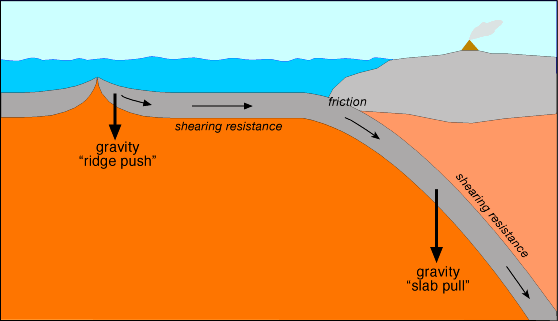
Does mantle convection drive plate tectonics?
After the discovery of radioactivity by Marie Curie and Henri Becquerel in 1896 it became clear that the Earth's interior would be heated by radioactive decay in the mantle and crust. Rock is a poor conductor of heat. If there were not some other mechanism to cool the interior the Earth's interior would be largely molten. Yet the growing seismic data from around the turn of the and first two decades of the 20th century showed that the crust and mantle were solid. Holmes proposed that the interior was cooled by convection of the solid, ductile mantle. By 1928 Holmes used mantle convection as a mechanism to produce continental drift as discussed by Wegener and DuToit. But the concept of a convecting solid mantle wasn't very palatable to the scientific mainstream of the time.
In the 1960s with the plate tectonics revolution, an early hypothesis for a driving force for seafloor spreading was back to mantle convection. In fact, convection almost certainly does occur in the mantle. Seismic tomography of the mantle shows areas of lower seismic velocities - lower density (hotter) mantle rock which presumably are rising and other areas of higher seismic velocity - higher density (not as hot) rock which should be sinking. But some plates are very wide, thousands of kilometers from the ridge to the trench, and it doesn't seem plausible to have a convection cell that is very wide (thousands of kilometers) in comparison to its depth (less than 670 km). Seismic tomography shows that rising mantle material beneath ridges only extends down 200 to 400 km. Moreover, interpretation of geoid anomalies, based on variation in gravity produced by upwelling and downwelling regions, indicates that there are multiple convection cells beneath the Pacific plate. The combined effect would not be one that would drive the motion of the plate - some cells would help, some would hinder. Additionally, the asthenosphere is weak enough that relatively little force would be applied to the base of the oceanic lithosphere by convecting mantle.
So, if not convection, then what?
The most important forces: gravity = "ridge push" and "slab pull" (Forsyth and Uyeda, 1975)
"ridge push" The lithosphere thickens with distance (and time) away from the midocean ridge. This is because it cools as it moves away from the ridge and the boundary between the solid lithosphere and slightly molten asthenosphere becomes deeper - the boundary between the lithosphere and asthenosphere is essentially a temperature boundary. The result of this thickenning with distance from the ridge is that the lithosphere/asthenosphere boundary slopes away from the ridge. The weight of the lithosphere on this sloping surface produces a downslope force. And since the asthenosphere is weak, the weight of the lithosphere near the ridge sliding down the "slippery slope" of the asthenosphere "pushes" the older part of the plate in front of it. Note that as the lithosphere slides down away from the ridge, tensional forces and normal fault earthquakes occur at the ridge axis where two plates are sliding (pulling) apart.
"slab pull" As lithospheric plates move away from midocean ridges they cool and become denser. They eventually become more dense than the underlying hot mantle. After subducted, cool, dense lithosphere sinks into the mantle under its own weight. This helps to pull the rest of the plate down with it.

resisting forces The main effect of the underlying mantle is to produce a shearing or frictional force resisting the motion of lithospheric plates. And for newly subducting slabs, the resisting force of the mantle as the slab tries to force its way through is stronger than the shearing on the top and bottom of the descending slab. Friction between the converging plates and also the force required to bend a plate resist the movement of the plate at subduction zones.
It seems likely that gravity drives the plates and the motions of the plates help to stir the mantle, rather than the convection of the mantle driving the plates.
However, mantle flow may be important locally with respect to the motion of continents with deep keels (thickened lithosphere, especially in old orogenic belts), but not for oceanic lithosphere.